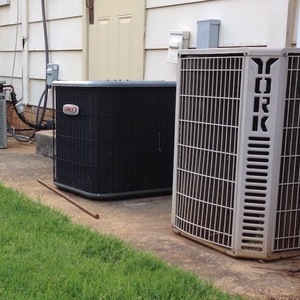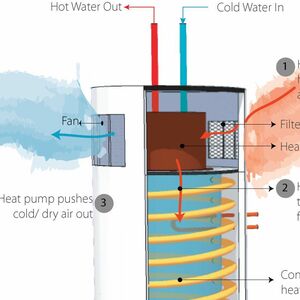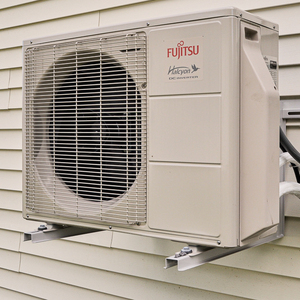
We do a lot of HVAC design (third party, all over the U.S.) at Energy Vanguard. I’ve also written a lot about it here in this blog and in my book. And if you’ve been reading any of those pieces, you probably know I like rules of thumb. Well, today I’m going to tell you about one of our rules of thumb. Yeah, the one in the title: 5 tons is never the right answer.
But first, if you don’t already know what the heck I’m talking about, let me explain. Air conditioner and heat pump capacity is often given in tons. One ton of cooling capacity is equivalent to 12,000 BTU per hour, so 5 tons would be 60,000 BTU per hour. (There’s an interesting history behind the ton of cooling capacity.)
Below are our two reasons why 5 tons is never the right answer.
Most houses don’t need 5 tons
As I showed in our data, our load calculations average out to 1 ton for each 1200 sq. ft. of conditioned floor area. That drops to about 900 sq. ft. per ton for the equipment sizes we specify. So, using the second number, we’d need 5 tons only for a 4500-sq.-ft. house. We do houses that large and even larger, but the average house size in the U.S. is less than 2500 sq. ft.
Take Bill Spohn’s brand-new net zero–energy high-performance home in Pittsburgh, Pennsylvania. The photo above is the outdoor unit for his heat pump. He’s heating and cooling 4400 sq. ft. with only a 2-ton heat pump.
What about older houses, you ask? Well, I live in one of those. It was built in 1961. The total floor area is 3900 sq. ft. I have a 2 ton system serving most of the main floor. I have half-ton ductless unit in the sunroom. And when I get to that part of the basement, I’m going to install a 1-ton heat pump. That’s 3.5 tons in 3900 sq. ft. That’s 1100 sq. ft. per ton for a pretty good old house!
Houses that need 5 tons need more than one system
For larger houses that do need 5 tons of total capacity, we don’t specify a single 5-ton system. We typically specify two or more systems—sometimes many more. And that’s true even for smaller houses. My house will have three separate systems when I’m done with the basement.
Putting in multiple systems provides some good advantages. For example, it makes heating and cooling different parts of the house differently possible. Like the bedrooms cooler? Just set that system’s thermostat lower and leave the other ones set higher.
It’s also great for resiliency. But to get the full resiliency of multiple systems, you have to put in one outdoor unit for each indoor unit rather than one outdoor unit connected to multiple indoor units. The latter will provide some extra resiliency because one indoor unit going out doesn’t knock out all your heating and cooling. If you have only one outdoor unit, though, you lose all your heating and cooling when it goes out. (See my article on one-to-one versus multi-splits for more.)
Finally, multiple smaller systems makes it a lot easier to design duct systems. With a single 5-ton system, you’ve got to distribute air over what’s probably a very large house. If you’ve ever done duct design for a large house, you know that’s not an easy task. There’s inevitably a beam or stairs or some other obstacle that makes it difficult. (So, you architects who are designing houses, please think about giving us space in more than one place for the air handlers.)
Capacity is lower
When I published this article in the Energy Vanguard Blog, RoyC (who works for a manufacturer) commented: “Ducted equipment manufacturers optimize their designs around 3-ton equipment since that is the largest sales volume. If you look at a given product family (2-5 tons) for a given manufacturer, the 5-ton model usually has the lowest rated capacity [compared to nominal capacity].”
So, you may be paying for 5 tons of nominal capacity and getting than you would for models that are rated at 2 or 3 tons.
The nitty gritty
So, yeah, 5 tons is never the right answer. It’s possible to make it work if you really have to, but there will almost certainly be air distribution and comfort problems in the house. You could try zoning to make it work, but zoned systems often have problems. (And of course, never use a bypass duct if you do zone.) Keep your equipment small, your ducts large, and your thumbs free of rules.
____________________________________________________________________
Allison A. Bailes III, PhD is a speaker, writer, building science consultant, and the founder of Energy Vanguard in Decatur, Georgia. He has a doctorate in physics and is the author of a bestselling book on building science. He also writes the Energy Vanguard Blog. For more updates, you can subscribe to our newsletter and follow him on LinkedIn.
Weekly Newsletter
Get building science and energy efficiency advice, plus special offers, in your inbox.















2 Comments
Perhaps you can clarify if your specifically targeting single zone 5ton ducted systems. For example, it sounds like a 5 ton outdoor unit with multiple indoor air handlers would satisfy all of your (valid) concerns, but you don't seem to say so explicitly. (At least as far as I can see?)
I think multiple air handlers on a single multi split 'system' may also be problematic in terms of efficiency, but that's a subtle point.
“[Deleted]”
Log in or create an account to post a comment.
Sign up Log in